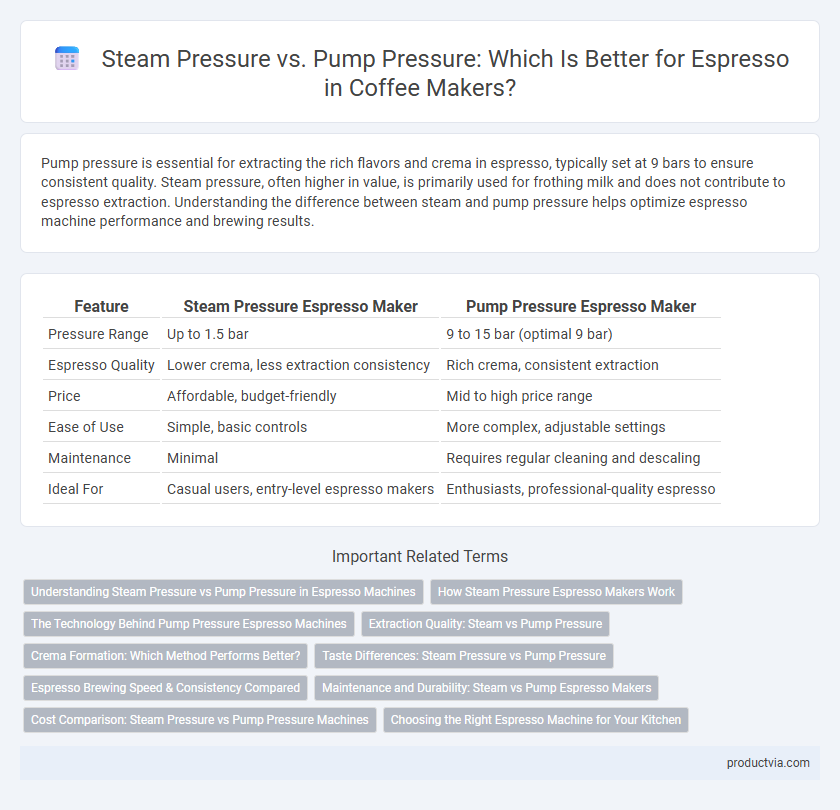Pump pressure is essential for extracting the rich flavors and crema in espresso, typically set at 9 bars to ensure consistent quality. Steam pressure, often higher in value, is primarily used for frothing milk and does not contribute to espresso extraction. Understanding the difference between steam and pump pressure helps optimize espresso machine performance and brewing results.
Table of Comparison
| Feature | Steam Pressure Espresso Maker | Pump Pressure Espresso Maker |
|---|---|---|
| Pressure Range | Up to 1.5 bar | 9 to 15 bar (optimal 9 bar) |
| Espresso Quality | Lower crema, less extraction consistency | Rich crema, consistent extraction |
| Price | Affordable, budget-friendly | Mid to high price range |
| Ease of Use | Simple, basic controls | More complex, adjustable settings |
| Maintenance | Minimal | Requires regular cleaning and descaling |
| Ideal For | Casual users, entry-level espresso makers | Enthusiasts, professional-quality espresso |
Understanding Steam Pressure vs Pump Pressure in Espresso Machines
Steam pressure in espresso machines typically ranges from 0.8 to 1.5 bar and uses heated steam to force water through coffee grounds, often resulting in inconsistent extraction and bitter flavors. Pump pressure, commonly set around 9 bar, provides a steady and precise force that ensures optimal extraction of oils and flavors, producing richer and balanced espresso. Understanding the difference between steam pressure and pump pressure helps in selecting machines that deliver quality espresso with consistent crema and taste.
How Steam Pressure Espresso Makers Work
Steam pressure espresso makers operate by heating water in a boiler to produce steam, which forces hot water through the coffee grounds at approximately 1.5 bar of pressure. This lower pressure compared to pump-driven machines, which typically reach 9 bars, results in a different extraction profile affecting flavor and crema quality. Understanding the mechanics of steam pressure helps users optimize brew time and grind size to achieve the best espresso taste from these traditional devices.
The Technology Behind Pump Pressure Espresso Machines
Pump pressure espresso machines utilize an electric pump to generate a consistent and controllable pressure, typically around 9 bars, which is optimal for extracting rich espresso flavors and crema. This technology ensures precise water flow and temperature stability, resulting in a superior brew compared to steam pressure machines, which rely on boiler-generated steam pressure that is less consistent and generally lower. The advancement of pump pressure systems has revolutionized home and professional espresso making by delivering reliable pressure control for optimal extraction and flavor complexity.
Extraction Quality: Steam vs Pump Pressure
Steam pressure in espresso machines typically ranges from 1.5 to 2.5 bars but often fluctuates, resulting in inconsistent extraction quality and potential bitterness in espresso. Pump pressure machines maintain a steady 9 bars, ensuring optimal water flow through coffee grounds for balanced flavor extraction and crema formation. Consistent pump pressure significantly enhances espresso's aroma, richness, and overall sensory profile compared to variable steam pressure extraction.
Crema Formation: Which Method Performs Better?
Pump pressure machines generate a consistent 9 bars of pressure, essential for optimal crema formation by forcing hot water through finely ground coffee, resulting in a rich, thick, and stable crema layer. Steam pressure models typically deliver lower and less controlled pressure, often below 1.5 bars, which limits extraction quality and produces a thinner, less persistent crema. For superior espresso with a dense crema, pump pressure systems outperform steam pressure machines due to precise pressure regulation critical during the brewing process.
Taste Differences: Steam Pressure vs Pump Pressure
Steam pressure espresso machines typically generate pressure around 1.5 bar, resulting in a less consistent extraction that often produces a burnt or over-extracted taste with muted flavor complexity. Pump pressure machines operate at a precise 9 bar, enabling a more even extraction that highlights the espresso's rich aroma, balanced acidity, and smooth mouthfeel. The controlled pressure of pump systems ensures enhanced crema quality and fuller-bodied flavor profiles, preferred by espresso connoisseurs.
Espresso Brewing Speed & Consistency Compared
Pump pressure in espresso machines typically delivers a consistent 9 bars of pressure, ensuring quick extraction within 25-30 seconds, which enhances espresso brewing speed and consistency. Steam pressure, often lower and less stable around 1-1.5 bars, leads to slower extraction times and inconsistent espresso flavor profiles. Machines relying on pump pressure provide more precise control over brewing parameters, resulting in a uniform crema and balanced taste shot after shot.
Maintenance and Durability: Steam vs Pump Espresso Makers
Steam espresso makers operate at higher steam pressure, which can cause quicker wear and scale buildup in boilers, requiring more frequent maintenance to preserve durability. Pump espresso machines use consistent pump pressure, reducing stress on components and enhancing longevity with less frequent servicing. Regular descaling and cleaning are crucial for both types, but pump machines generally offer better maintenance ease and longer lifespan due to controlled pressure systems.
Cost Comparison: Steam Pressure vs Pump Pressure Machines
Steam pressure espresso machines generally cost less upfront, making them a budget-friendly option for casual home users, while pump pressure machines demand a higher initial investment due to their advanced technology and consistent pressure control. Repair and maintenance expenses tend to be higher for pump machines because of their complex components, whereas steam machines often incur lower service costs but offer less precise espresso extraction. Considering long-term value, pump pressure machines provide superior espresso quality and durability, justifying their greater cost for enthusiasts and professional use.
Choosing the Right Espresso Machine for Your Kitchen
Steam pressure espresso machines generate pressure by boiling water to create steam, typically reaching around 1.5 bar, which often produces less consistent extraction and crema. Pump pressure machines use an electric pump to deliver a stable 9 bar pressure, ensuring optimal espresso flavor and crema quality. Selecting a pump-driven espresso machine is ideal for home kitchens aiming for professional-grade espresso and consistent brewing performance.
Steam pressure vs Pump pressure for espresso Infographic

 productvia.com
productvia.com